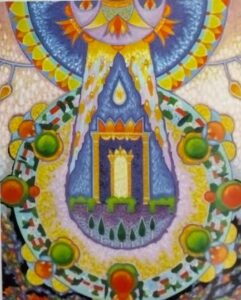בס”ד
By Rabbi Moshe Goodman, Kollel Ohr Shlomo, Hebron

In this painting we see figures of people adjacent to the Beit Hamikdash, along with houses surrounding
it. The connection of the People tot the Beit Hamikdash seems to be a major theme in this parsha. This
parsha begins with the service of the Levites in the Beit Hamikdash and continues to discuss the
ramifications this Temple has on the People, such as its implications on the Jewish couple through the
episode of Sotah, the human-induced nazirite oath and its implications on an entire procedure in the
Temple, the implications of the Temple upon stealing from a fellow Jew, I.e requiring an offering in the
Temple to be made, the blessing of the Kohanim, the priests of the Temple, upon the People, the bringing
of offerings to the Temple from the People’s tribal princes, and more. This idea seems to be a continuation
from last week’s parsha which specified that the Temple be amidst the encampments of the People on a
topographical level, and then this parsha specifies how the “centrality of the Temple amongst the People”
is such on a functional way as well. The Temple, place of God’s Holy Presence, also acts as a unifying
force among the People, showing how the many masses of the People are ultimately united to the One
God.
We see the Beit Hamikdash withib a blue drop of water/dew which also has within it a yellow drop which
may hint to a drop of anointing oil used to sanctify the vessels of the Temple.
We see seven fruits surrounding the Temple, and seven trees underneath it, seemingly hinting to the
importance of thls number in Judaism generally and in the Temple more specifically as seen, for example,
in the seven days of the Miluim that preceded the inauguration of the Mishkan.
All these ideas seem to fit perfectly with the chapter 133 of Tehilim:
A song of ascents of David. Behold how good and how pleasant it is for brothers also to dwell together!
As the good oil on the head runs down upon the beard, the beard of Aaron, which runs down on the
mouth of his garments.
As the dew of Hermon which runs down on the mountains of Zion, for there the Lord commanded the
blessing, life forever.
Shavuot as well is a time when we remember our inherent unity as our Sages say that Israel encamped
at Mount Sinai united “with one heart.” It is through this unity that Israel merited to receive the holy
blessing of the Torah which also unites us all in one covenant with the One Creator. May we merit to
this blessing especially at this time!
Of course this theme of unity and life of sanctity and blessing fit perfectly with the holy City of Hebron,
the City of Unity, the City of the Blessings of the Patriarchs!



